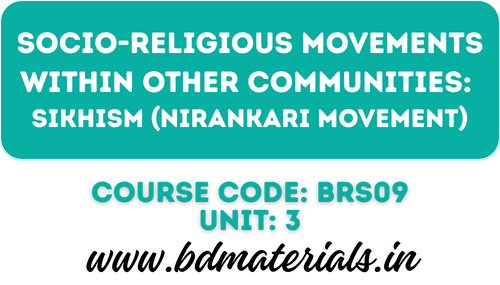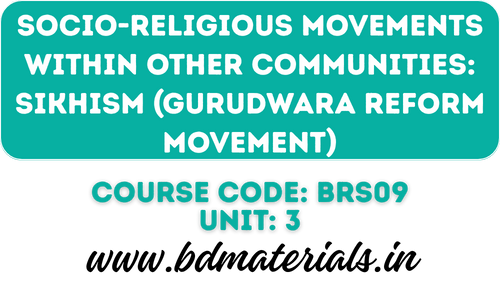Socio-Religious Movements within Hinduism: Ramakrishna Mission
Ramakrishna Mission is an Indian religious organization that forms the core of a worldwide spiritual movement known as the Ramakrishna Movement or the Vedanta Movement. The mission is a philanthropic volunteer organization founded by Ramakrishna’s chief disciple Swami Vivekananda on 1 May 1897. The mission conducts extensive work in health care, disaster relief, rural management, tribal welfare, elementary and higher education and culture. It uses the combined efforts of hundreds of ordered monks and thousands of householder disciples. The mission bases its work on the principles of karma yoga.
The mission, which is headquartered near Kolkata at Belur Math in Howrah, West Bengal, subscribes to the ancient Hindu philosophy of Vedanta. It is affiliated with the monastic organization Ramakrishna Math, with whom it shares members.
History
Ramakrishna Paramahansa (1836–1886), regarded as a 19th-century saint, was the inspiration for the Ramakrishna Order of Monks and is regarded as the spiritual founder of the Ramakrishna Movement. Ramakrishna was a priest in the Dakshineswar Kali Temple and attracted several monastic and householder disciples. Narendranath Dutta, who later became Vivekananda, was one of the chief monastic disciples. According to Vrajaprana, shortly before his death in 1886, Ramakrishna gave the orangey cloths to his young disciples, who were planning to become renunciates. Ramakrishna entrusted the care of these young boys to Vivekananda. After Ramakrishna’s death, the young disciples of Ramakrishna gathered and practiced spiritual disciplines. They took informal monastic vows on a night which, to their pleasant surprise, turned out to be Christmas Eve in 1886.
After the death of Ramakrishna in 1886, the monastic disciples formed the first Math (monastery) at Baranagore. Later, Vivekananda became a wandering monk, and in 1893, he was a delegate at the 1893 Parliament of the World’s Religions. His speech there, beginning with “Sisters and Brothers of America,” became famous and brought him widespread recognition. Vivekananda went on lecture tours and held private discourses on Hinduism and spirituality. He also founded the first Vedanta Society in the United States in New York. He returned to India in 1897 and founded the Ramakrishna Mission on 1 May 1897. Though he was a Hindu monk and was hailed as the first Hindu missionary in modern times, he exhorted his followers to be true to their faith but respect all religions of the world as his guru Ramakrishna had taught that all religions are pathways to God. One such example is his exhortation that one can be born in a church, but he or she should not die in a church, meaning that one should realize the spiritual truths for themselves and not stop blindly believing in doctrines taught to them. The same year, famine relief was started at Sargachi by Swami Akhandananda, a direct disciple of Ramakrishna. Swami Brahmananda, a direct disciple of Ramakrishna, was appointed as the first president of the Order. After the death of Vivekananda in 1902, Sarada Devi, the spiritual counterpart of Ramakrishna, played an important role as the advisory head of a nascent monastic organization. Gayatri Spivak writes that Sarada Devi performed her role with tact and wisdom, always remaining in the background.
The Motto and Principles
The aims and ideals of the Mission are purely spiritual and humanitarian and have no connection with politics. Vivekananda proclaimed that renunciation and service are the twofold national ideals of modern India, and the work of the mission strives to practice and preach these. The service activities are based on the message of Jiva Shiva from Ramakrishna and Vivekananda’s message of Daridra Narayana to indicate that service to the poor is service to God. The Principles of Upanishads and Yoga in Bhagavad Gita, reinterpreted in the light of Ramakrishna’s Life and Teachings, is the main source of inspiration for the Mission. The service activities are rendered looking upon all as veritable manifestations of the Divine. The Motto of the organization is Atmano Mokshartham Jagad-pitaya Cha, which means For one’s own salvation and for the good of the world.
Religious Activities
The mission is a non-sectarian organization and ignores caste distinctions. Ramakrishna ashrama’s religious activities include satsang and arati. Satsang includes communal prayers, songs, rituals, discourses, reading and meditation. Arati involves the ceremonial waving of lights before the images of a deity or a holy person and is performed twice a day. Ramakrishna ashramas observe major Hindu festivals, including Maha Shivarathri, Rama Navami, Krishna Asthami and Durga Puja. They also give special places to the birthdays of Ramakrishna, Sarada Devi, Swami Vivekananda, and other monastic disciples of Ramakrishna. The 1st of January is celebrated as Kalpataru Day. The event commemorates the day on January 1, 1886, when his followers believe that Ramakrishna revealed himself to be an Avatar, or God incarnate on earth. The event includes providing medical care, blankets and clothing for the poor.
The math and the mission are known for their religious tolerance and respect for other religions. Among the earliest rules laid down by Swami Vivekananda for them was, “Due respect and reverence should be paid to all religions, all preachers, and to the deities worshiped in all religions.” Acceptance and toleration of all religions is one of the ideals of Ramakrishna Math and Mission. Along with the major Hindu festivals, Christmas Eve and Buddha’s Birthday are also devoutly observed. Cyril Veliath of Sophia University writes that the Ramakrishna Mission monks are a relatively orthodox set of monks who are extremely well respected both in India and abroad and that they cannot be classified as just another sect or cult, such as the groups led by the gurus. Veliath writes that of the Hindu groups I have worked with, I have found the Ramakrishna Mission to be the most tolerant and amenable to dialogue, and I believe that we Christians couldn’t do better than to cooperate wholeheartedly in their efforts towards interreligious harmony. Bob Robinson writes, Unlike more militant Hindu organizations, the mission has consistently advocated, and itself displayed a tolerant, friendly attitude towards minority religious traditions and a sympathetic acquaintance with at least parts of the scriptures of those faiths.
Evaluation
Vivekananda, although considered a jnana yogin who renounced the world, was also a karma yogin. His whole life was given to activities. He was committed to a philosophy of action. He used to say, I Love action…let me live and die in action. His vision was to make the monks devote themselves to an active life of service for the masses. Hence, the Ramakrishna mission was organized to carry out philanthropic, charitable, religious and educational missionary activities. The regular activities of the Ramakrishna Mission are as follows: famine & plague relief, orphanages, schools and colleges, hospitals, maths (monasteries), two magazines in English, and a monthly journal in Bengali.
Therefore, Vivekananda was also the first Indian to be called a socialist. The keynote of his attitudes towards the Indian National question was the uplift of the Indian masses. He called the masses jana narayana (God in the form of the masses). His contribution was in nation-building activities. He said: the soil of India is my highest heaven; India’s good is my good.
D.S. Sarma evaluates the socio-religious movements within Hinduism and says that the movements that preceded the Ramakrishna Mission were poor and inadequate representations of the great historical religion of the Hindus. The Brahmo Samaj was mere eclecticism, more Christian than Hindu in character, whereas the religion of the Arya Samaj was mere Vedism, which ignored all the later developments in Hinduism. On the other hand, the Ramakrish na Mission under Swami Vivekananda was doubtless not only a full but also an authentic manifestation of Hinduism. However, although he learned much from the West and advocated respect for all religions, Vivekananda was highly critical of Christian Missionary work in India. Evidently, it was their negative approach that he condemned.
Friendly Note
Bachelor of Divinity Materials is your go-to resource for comprehensive Biblical studies, supporting students in Bachelor of Divinity (B.D.) and other theological courses. Our platform offers access to the full syllabus, detailed answers, and a vast collection of assignments, study guides, articles, and research papers to help you excel academically.
We provide downloadable PDFs of study materials, including books and journals, for convenient learning anytime, anywhere. Whether preparing for exams or conducting research, our resources cater to both students and scholars in biblical studies.
Committed to empowering theological learners, we aim to deliver high-quality, authentic study materials. Explore Bachelor of Divinity Materials to deepen your understanding of God’s Word and Christian doctrine, making it a valuable resource for aspiring ministers and anyone dedicated to theology.







